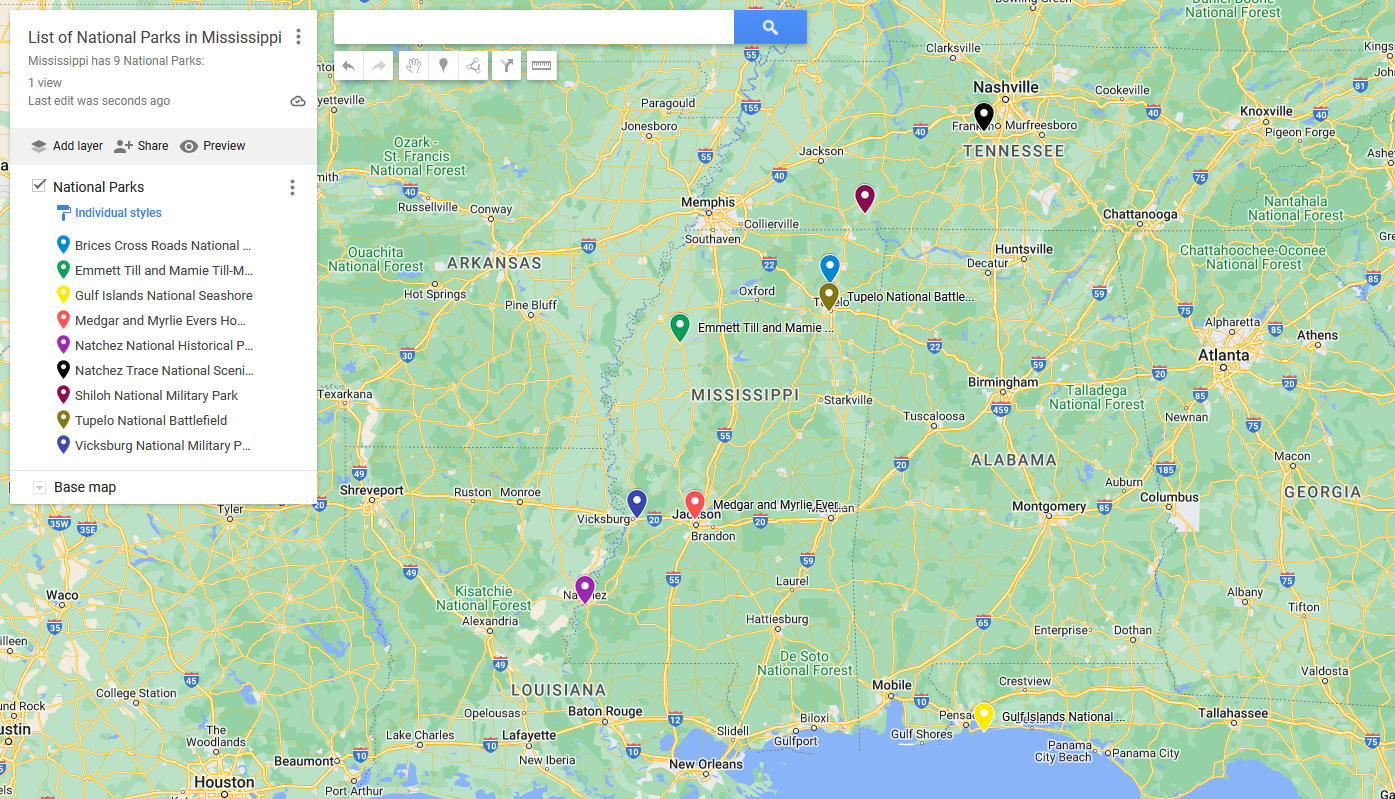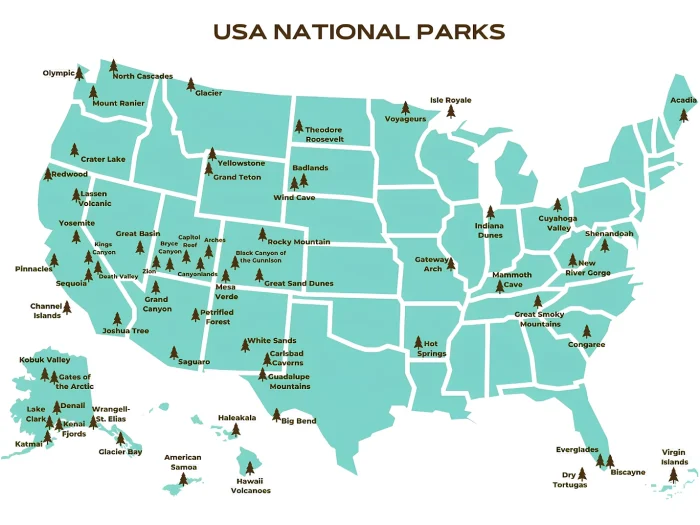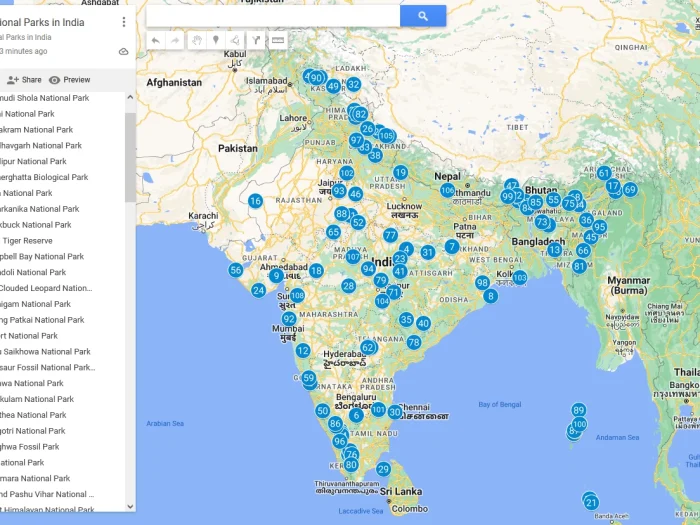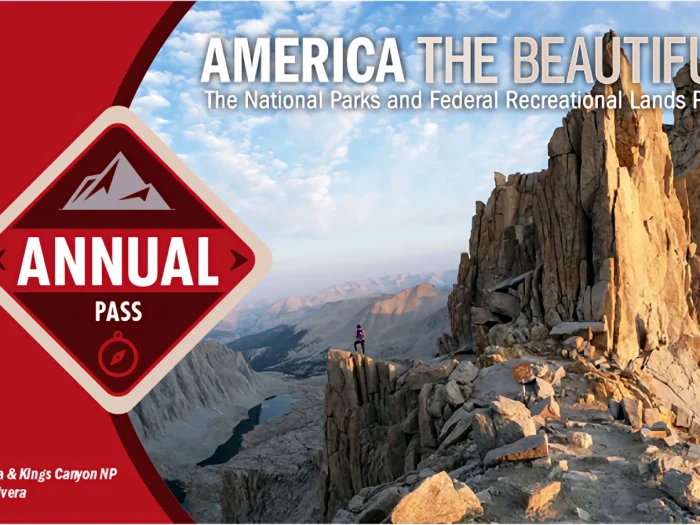List of National Parks in Mississippi
Mississippi has 9 National Parks:
- Brices Cross Roads National Battlefield Site
- Emmett Till and Mamie Till-Mobley National Monument
- Gulf Islands National Seashore
- Medgar and Myrlie Evers Home National Monument
- Natchez National Historical Park
- Natchez Trace National Scenic Trail
- Shiloh National Military Park
- Tupelo National Battlefield
- Vicksburg National Military Park
In this article I will write about these National Parks. I also add Mississippi National Parks map at the end of the article.
List of National Parks in Mississippi
(You can click the image below to see Mississippi National Parks map in full size)

1. Brices Cross Roads National Battlefield Site
Brices Cross Roads National Battlefield Site is a small but significant Civil War battlefield located in northeastern Mississippi, about 6 miles west of Baldwyn. This site commemorates the Battle of Brices Cross Roads, which took place on June 10, 1864, during the American Civil War.
Visitor Information
- Open Year-Round: The site is accessible every day from dawn to dusk.
- Free Admission: There is no charge to visit the battlefield site.
- Limited Facilities: As a small site, there are no extensive facilities on the grounds.
Visitor Experience
- Self-Guided Tours: Visitors can explore the site and read the interpretive markers at their own pace.
- Nearby Visitor Center: While not on the battlefield itself, the Mississippi’s Final Stands Interpretive Center in Baldwyn offers more in-depth information about the battle.
- Picnic Area: A small picnic area is available for visitors.
2. Emmett Till and Mamie Till-Mobley National Monument
The Emmett Till and Mamie Till-Mobley National Monument is a relatively new addition to the National Park System, designated on July 25, 2023. This monument commemorates the life and legacy of Emmett Till, a 14-year-old African American boy from Chicago who was brutally murdered in Mississippi in 1955, and his mother Mamie Till-Mobley, who became a civil rights activist following her son’s death.
The national monument consists of three separate sites:
- Graball Landing (Mississippi): The site where Emmett Till’s body was believed to have been recovered from the Tallahatchie River.
- Tallahatchie County Second District Courthouse (Mississippi): Where the trial of Till’s murderers took place.
- Roberts Temple Church of God in Christ (Chicago, Illinois): Where Emmett Till’s funeral was held.
Visitor Experience:
As a newly established monument, the visitor experience is still developing. However, visitors can expect:
- Interpretive Exhibits: Information about Till’s life, death, and its historical context.
- Guided Tours: Potentially offered at the different sites as the monument develops.
- Educational Programs: Likely to be developed to engage visitors with this important history.
3. Gulf Islands National Seashore
Gulf Islands National Seashore is a stunning national park that stretches across the Gulf Coast of Florida and Mississippi. Established in 1971, it encompasses barrier islands, sparkling white beaches, historic forts, and diverse marine and terrestrial ecosystems.
Natural Features:
- Beaches: Miles of pristine white sand beaches
- Barrier Islands: Several islands protecting the mainland coast
- Coastal Forests: Pine and oak woodlands
- Salt Marshes: Important estuarine habitats
- Marine Areas: Includes parts of Mississippi Sound and the Gulf of Mexico
Wildlife:
- Marine Life: Dolphins, sea turtles, various fish species
- Birds: Over 280 species, including ospreys and pelicans
- Land Animals: Deer, raccoons, armadillos
- Endangered Species: Home to several, including the Perdido Key beach mouse
Recreational Activities:
- Swimming and Sunbathing: Popular on the park’s many beaches
- Fishing: Both surf fishing and pier fishing available
- Boating: Several boat launches and marinas within the park
- Hiking: Nature trails on various islands and mainland areas
- Camping: Campgrounds available in Florida units
- Snorkeling and Diving: Clear waters offer good visibility
- Birdwatching: Excellent opportunities, especially during migration seasons
4. Medgar and Myrlie Evers Home National Monument
The Medgar and Myrlie Evers Home National Monument is a relatively new addition to the National Park System, established on March 12, 2019. This site preserves the home of civil rights activists Medgar and Myrlie Evers in Jackson, Mississippi.
Historical Significance:
- Medgar Evers: A prominent civil rights activist and the first field secretary for the NAACP in Mississippi.
- Assassination: Medgar Evers was assassinated in the driveway of this home on June 12, 1963.
- Civil Rights Movement: The home and the events surrounding Evers’ murder played a significant role in the Civil Rights Movement.
- Myrlie Evers: Medgar’s wife, who continued his civil rights work and later became chairwoman of the NAACP.
Visitor Experience:
- Exterior Viewing: Visitors can view the exterior of the home and grounds.
- Guided Tours: Limited tours may be available by appointment.
- Educational Programs: Developing programs to educate visitors about the Evers family and civil rights history.
5. Natchez National Historical Park
Natchez National Historical Park, established in 1988, is located in Natchez, Mississippi. This park preserves and interprets the complex history of Natchez, from Native American settlements through European colonization, the antebellum period, and into the 20th century. It offers a unique insight into the social, economic, and cultural life of the American South, particularly during the antebellum era.
The park consists of three main sites:
- Melrose Estate
- William Johnson House
- Fort Rosalie Site
Visitor Experience:
- Guided Tours: Available at Melrose and the William Johnson House
- Self-Guided Exploration: Grounds and gardens can be explored independently
- Exhibits: Interpretive displays at each site provide historical context
- Special Events: Living history demonstrations and seasonal programs
Visitor Information:
- Open Year-Round: Check for specific site hours
- Entrance Fees: Vary by site; some areas are free to access
- Best Time to Visit: Spring and fall offer pleasant weather; special events often occur during these seasons
6. Natchez Trace National Scenic Trail
The Natchez Trace National Scenic Trail, often simply called the Natchez Trace Parkway, is a unique 444-mile recreational road and parkway winding through over 10,000 years of history. It roughly follows the “Old Natchez Trace,” a historic travel corridor used by Native Americans, European explorers, traders, and soldiers.
Experiencing History:
- Ancient Footpath: Walk in the footsteps of prehistoric peoples on the original Natchez Trace path, experiencing a journey used for millennia.
- Native American Culture: Discover mounds, villages, and sacred sites of the Chickasaw and Choctaw nations, learning about their rich history and connection to the land.
- Early American Exploration: Trace the routes of famous figures like Meriwether Lewis and William Clark, and explore historic settlements like Natchez, Mississippi.
Things to Do:
- Visit historic sites: Explore preserved homesteads, battlefields, and significant locations like the Emerald Mound and the Tupelo National Battlefield.
- Picnic in nature: Take advantage of numerous scenic overlooks and designated picnic areas scattered throughout the parkway.
- Camping under the stars: Campgrounds along the parkway offer a chance to connect with nature and enjoy peaceful nights under the stars.
7. Shiloh National Military Park
Shiloh National Military Park, located in southwestern Tennessee, preserves the haunting battlefields of the Battle of Shiloh, a pivotal clash in the American Civil War. This solemn site offers visitors a poignant journey through one of the nation’s most defining periods.
A Glimpse into the Battle:
- Two-Day Struggle: The park encompasses the grounds where, over two bloody days in April 1862, Union and Confederate armies clashed in a brutal battle that shocked the nation with its ferocity.
- Heavy Casualties: The Battle of Shiloh resulted in over 23,000 casualties, a stark reminder of the devastating human cost of war. The park stands as a memorial to the soldiers from both sides who fought and died here.
- Turning Point: The Union victory at Shiloh proved to be a significant turning point in the war in the Western Theater, solidifying Union control of western Tennessee and opening the way for further advances south.
Experiencing the Park:
- Shiloh Battlefield Tour: Follow the self-guided driving tour through the battlefield, using the park brochure or audio tour to understand the events that unfolded at each stop.
- Key Landmarks: Visit key locations such as the Bloody Pond, the Hornet’s Nest, and the Shiloh Church, each marked with monuments and interpretive signs explaining their significance.
- Shiloh National Cemetery: Pay your respects at the National Cemetery, the final resting place for thousands of Union soldiers who died during the battle.
8. Tupelo National Battlefield
Tupelo National Battlefield, nestled in northeastern Mississippi, commemorates the Battle of Tupelo, a fierce clash during the late stages of the American Civil War. Though less renowned than some battles, Tupelo offers a poignant glimpse into the final chapters of the conflict.
Exploring the Battlefield:
- Compact Battlefield: Unlike sprawling battlefields like Shiloh or Gettysburg, Tupelo National Battlefield is relatively compact, making it easily navigable for visitors.
- Walking Trails: A network of walking trails wind through the battlefield, offering opportunities to stand on the very ground where soldiers fought and fell.
- Monuments and Markers: Monuments and interpretive markers throughout the park tell the story of the battle and highlight key locations and events.
Planning Your Visit:
Tupelo National Battlefield is open year-round, and admission is free. Be sure to stop by the visitor center to watch a short film about the battle and view exhibits that provide context and insights into the events that unfolded there.
A Somber Reminder:
Though smaller in scale than some Civil War battlefields, Tupelo National Battlefield offers a poignant reminder of the sacrifices made during one of America’s darkest chapters. It serves as a place for quiet reflection and a call to remember the human cost of conflict.
9. Vicksburg National Military Park
Vicksburg National Military Park preserves the site of the pivotal Vicksburg Campaign, a lengthy and decisive siege that gave Union forces control of the Mississippi River, effectively splitting the Confederacy in two. Visiting this park is to step back in time and witness a crucial chapter in American history.
Exploring the Park:
- Immersive Battlefield: The park encompasses a vast 1,800-acre battlefield, preserved much as it appeared during the siege. Drive or bike the 16-mile tour road, stopping at numerous points of interest along the way.
- Trenches and Earthworks: Walk through well-preserved trenches and earthworks, getting a sense of the harsh conditions faced by soldiers on both sides.
- USS Cairo Gunboat: Tour the remarkably preserved remains of the USS Cairo, a Union ironclad gunboat sunk during the campaign and later raised from the depths of the river.
- Vicksburg National Cemetery: Pay your respects at the Vicksburg National Cemetery, the final resting place for over 17,000 Union soldiers, many of whom died during the siege.
Plan Your Visit:
Allow ample time to fully explore the park, as there is much to see and absorb. The park is open year-round, with extended hours during peak seasons. Guided tours and ranger programs are available to enhance your visit.
Mississippi National Parks map on Google map
Now you can answer the question:”how many national parks are in Mississippi?” Mississippi has 9 national parks.
Read more:




